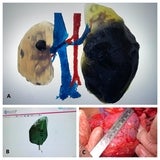What is Wilms tumor?
Wilms tumor, also called nephroblastoma, is a malignant (cancerous) tumor originating in the cells of the kidney. It is the most common type of renal (kidney) cancer and accounts for about 6 percent of all childhood cancers. As with any cancer, prognosis and long-term survival can vary greatly from child to child, but most children with Wilms tumor can be cured of the disease.
Wilms tumor is unrelated to adult kidney cancer. The tumor usually affects a single kidney, but approximately 5-10 percent of children with Wilms tumor have both kidneys involved.
Who is diagnosed with Wilms tumor?
Wilms tumor occurs in children up to about age 8. About 75 percent of cases occur before age 5, and the average age of children diagnosed with Wilms tumor is 2 to 3 years old. For unknown reasons, Wilms tumor affects more black children than white children.
The average age of diagnosis of Wilms tumor in children depends upon whether one or both kidneys are affected:
- If one kidney is affected (unilateral Wilms tumor), the age at diagnosis usually is 42-47 months
- If both kidneys are affected (bilateral Wilms tumor), the age at diagnosis usually is 30-33 months
Most cases of Wilms tumor occur by chance (sporadic). They are the result of mutations in cells in the kidneys that usually occur after birth. In some cases, however, a genetic defect increases the risk of Wilms tumor.
Signs and symptoms of Wilms tumor
Wilms tumor is characterized by:
- Abdominal swelling, often toward one side
- Fever
- Abdominal pain
- Constipation
- High blood pressure (hypertension)
- Large swollen veins across the abdomen
- Blood in the urine (hematuria)
- Fatigue
- Loss of appetite
- Weight loss
- Frequent urinary tract infections
Diagnosis of Wilms tumor
After taking a complete medical history and doing a physical examination of your child, the physician may also order the following tests to determine if the cancer has spread (metastasized):
- Abdominal ultrasound, This imaging test uses high-frequency sound waves and a computer to create pictures of internal organs, blood vessels, and tissues.
- Bone scan, This imaging test, which is used to detect bone cancer, uses a special radioactive material that is injected into a vein. The substance collects in areas of diseased bone and is sensed by special cameras that pick up radioactivity.
- Abdominal computerized tomography scan (CT or CAT scan), This imaging test uses X-rays and computer technology to produce detailed cross-sectional images (slices) of the body, including the bones, muscles, fat, and organs. It can show a mass in the kidneys and whether the cancer has spread to other organs such as the lungs.
- Chest X-ray, This imaging test produces images of the heart, lungs, and bones.
- Magnetic resonance imaging (MRI), An MRI scan uses radio waves and strong magnets with computer technology. MRI shows more detailed images than CT and ultrasound and can help doctors see if the cancer has invaded one of the major blood vessels located near the kidney.
- Blood and urine tests, These laboratory tests help evaluate kidney and liver function.
- Biopsy, A sample of tissue is removed and examined under a microscope; this helps confirm the diagnosis and aids in the treatment plan.
Treatment for Wilms tumor
At CHOP, your child will be treated by a multidisciplinary team including surgeons, oncologists, urologists, radiologists, radiation oncologists, pathologists and nurse practitioners, who work together to create a treatment plan specific to your child. You and your child will meet with the treatment team to ensure your family has an opportunity to build a trusting relationship with them.
Proton therapy
Proton therapy, a more targeted form of radiation therapy, is offered at Children's Hospital of Philadelphia as a treatment option for Wilms tumor. This therapy is provided in partnership with Penn Medicine at the Roberts Proton Therapy Center.
The overall cure rate for Wilms tumor is 85 percent. As with any cancer, however, prognosis and long-term survival can vary greatly from child to child. Prompt medical attention and aggressive therapy are important for the best prognosis. Continuous follow-up care is essential for a child diagnosed with Wilms tumor because side effects of radiation and chemotherapy may occur as well as second malignancy.

Get a Second Opinion from CHOP
Our experts are here to review your child's diagnosis and treatment plan, and work with primary oncologists as needed
Surgery for Wilms Tumor
Most children with Wilms tumor will require surgery as part of their treatment plan. At CHOP, your child will be treated by a multidisciplinary team including surgeons, oncologists, radiation oncologists and nurse practitioners, who work together to create a treatment plan specific to your child. You and your child will meet with the treatment team to ensure your family has an opportunity to build a trusting relationship with them. Scans are done prior to surgery to evaluate the extent of the tumor in the kidney and determine whether it has spread to other parts of the body, such as the lungs.
The affected kidney, either in whole or sometimes in part, may be surgically removed. If the whole kidney is removed, this is called a nephrectomy. In certain situations, CHOP surgeons can perform nephron-sparing surgery (NSS), also known as partial nephrectomy, meaning that only part of the kidney is removed. NSS has been advocated in cases of bilateral Wilms tumor, for which the only alternative is bilateral nephrectomy, in cases of multifocal unilateral disease, or with Wilms tumor predisposition syndromes. NSS can be performed with a minimal complication rate and with no increase in the incidence of tumor recurrence and should be considered the standard modern approach to the management of selected cases of Wilms tumor.

The use of several evaluation and surgical techniques have optimized successful surgical outcomes. We calculate the likelihood of complications after partial nephrectomy using several factors to come up with a complexity score. We’ve found that the majority of Wilms tumors that have high-intermediate complexity (a high score) may still successfully undergo NSS, rather than a total nephrectomy, as is often recommended. 3D models of the individual patient’s kidneys contribute to this success. A 3D model allows the surgeon to view the organ and the location of the tumor from various angles to better understand anatomical relationships. In certain instances, a tumor will be further evaluated using intra-operative ultrasound to fully understand the extent of the tumor.
The typical recovery after surgery includes a three- to five-day stay in the hospital. We work with our anesthesia team to optimize pain control after surgery. We also encourage early walking after surgery and do expect a return to normal activities within one to two weeks.
Learn about CHOP's surgical approach if your child has been diagnosed with Wilms tumor.
Chemotherapy and Radiation for Wilms Tumor
Chemotherapy and sometimes radiation are used to kill remaining cancer cells.
The overall cure rate for Wilms tumor is 85%. As with any cancer, however, prognosis and long-term survival can vary greatly from child to child. Prompt medical attention and multidisciplinary therapy are important for the best prognosis. Regular follow-up care is essential for a child diagnosed with Wilms tumor to monitor for tumor recurrence and long-term side effects of radiation and chemotherapy.
Late Effects/Cancer Survivorship
Some children treated for Wilms tumor develop complications many years later. Our Cancer Survivorship Program provides you and your child with information about the potential long-term effects of the specific treatment your child received and ways of monitoring and treating these effects.
Resources to help
Wilms Tumor (Kidney Tumor) Resources
Cancer Center Resources
We have created resources to help you find answers to your questions and feel confident with the care you are providing your child.

